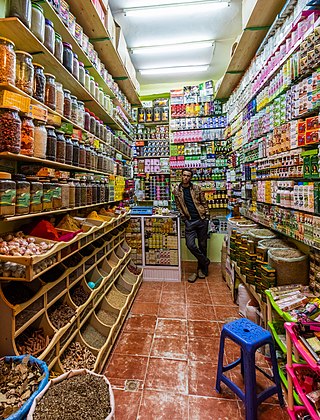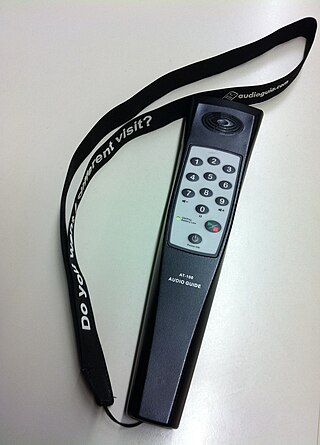
Library management is a sub-discipline of institutional management that focuses on specific issues faced by libraries and library management professionals. Library management encompasses normal managerial tasks, as well as intellectual freedom and fundraising responsibilities. Issues faced in library management frequently overlap with those faced in managing non-profit organizations.

Tourism is travel for pleasure, and the commercial activity of providing and supporting such travel. The World Tourism Organization defines tourism more generally, in terms which go "beyond the common perception of tourism as being limited to holiday activity only", as people "travelling to and staying in places outside their usual environment for not more than one consecutive year for leisure and not less than 24 hours, business and other purposes". Tourism can be domestic or international, and international tourism has both incoming and outgoing implications on a country's balance of payments.

A museum is an institution dedicated to displaying and preserving culturally significant objects. Many museums have exhibitions of these objects on public display, and some have private collections that are used by researchers and specialists. Compared to a library, a museum hosts a much wider ranges of objects and usually focus around a specific theme such as the arts, science, natural history, local history, and other topics. Public museums that host exhibitions and interactive demonstrations are often considered to be tourist attractions, and many museums attract large numbers of visitors from outside their host country, with the most visited museums in the world regularly attracting millions of visitors annually.

A tourist attraction is a place of interest that tourists visit, typically for its inherent or an exhibited natural or cultural value, historical significance, natural or built beauty, offering leisure and amusement.

Retail is the sale of goods and services to consumers, in contrast to wholesaling, which is sale to business or institutional customers. A retailer purchases goods in large quantities from manufacturers, directly or through a wholesaler, and then sells in smaller quantities to consumers for a profit. Retailers are the final link in the supply chain from producers to consumers.

A general merchant store is a rural or small-town store that carries a general line of merchandise. It carries a broad selection of merchandise, sometimes in a small space, where people from the town and surrounding rural areas come to purchase all their general goods. The store carries routine stock and obtains special orders from warehouses. It differs from a convenience store or corner shop in that it will be the main shop for the community rather than a convenient supplement.
A souvenir , memento, keepsake, or token of remembrance is an object a person acquires for the memories the owner associates with it. A souvenir can be any object that can be collected or purchased and transported home by the traveler as a memento of a visit. The object itself may have intrinsic value, or be a symbol of experience. Without the owner's input, the symbolic meaning is lost and cannot be articulated.

Tourism in Mexico is a very important industry. Since the 1960s, it has been heavily promoted by the Mexican government as "an industry without smokestacks". Mexico has traditionally been among the most visited countries in the world according to the World Tourism Organization, and it is the second-most visited country in the Americas, after the United States. In 2017, Mexico was ranked as the sixth-most visited country in the world for tourism activities. Mexico has a significant number of UNESCO World Heritage Sites, with the list including ancient ruins, colonial cities, and natural reserves, as well as a number of works of modern public and private architecture. Mexico has attracted foreign visitors beginning in the early nineteenth century, with its cultural festivals, colonial cities, nature reserves and the beach resorts. The nation's temperate climate and unique culture – a fusion of the European and the Mesoamerican – are attractive to tourists. The peak tourism seasons in the country are during December and the mid-Summer, with brief surges during the week before Easter and Spring break, when many of the beach resort sites become popular destinations for college students from the United States.

Online shopping is a form of electronic commerce which allows consumers to directly buy goods or services from a seller over the Internet using a web browser or a mobile app. Consumers find a product of interest by visiting the website of the retailer directly or by searching among alternative vendors using a shopping search engine, which displays the same product's availability and pricing at different e-retailers. As of 2020, customers can shop online using a range of different computers and devices, including desktop computers, laptops, tablet computers and smartphones.

Tourism is a major industry in Macau. It is famous for the blend of Portuguese and Chinese cultures and its gambling industry, which includes Casino Lisboa, Macau, Sands Macau, The Venetian Macao, and Wynn Macau.

Cultural heritage tourism is a form of non-business travel whereby tourists engage with the heritage, tangible and intangible, moveable and immovable, of a region through activities, experiences, and purchases which facilitate a connection to the people, objects, and places of the past associated with the locations being visited. As opposed to natural heritage tourism, which focuses on visitors' interaction with the unimproved environment of the area being visited, including outdoor sports and recreation, hiking, diving, fishing, and naturalism, and pleasure tourism without any heritage interest, such as indoor recreation, gastronomy, and hospitality without any significant precedent in the history and heritage of the region, cultural heritage tourism can include activities such as tours of immovable cultural sites, such as historic house museums, historic fortifications, human history museums, and library documentary heritage collections, opportunities for purchases of moveable cultural property, such as antiques, antiquarian books, and other works and ephemera associated with the locations being visited, and opportunities for admission to or purchase of intangible heritage experiences associated with the tourism region, including gastronomic heritage and admissions to performances such as theatre, opera, ballet, indigenous dances, and storytelling.

A gift shop or souvenir shop is a store primarily selling souvenirs, memorabilia, and other items relating to a particular topic or theme. The items sold often include coffee mugs, stuffed animals, toys, t-shirts, postcards, handmade collections and other souvenirs, intended to be kept by the buyer as a memento of their visit, or given to another as a gift.

Sustainable tourism is a concept that covers the complete tourism experience, including concern for economic, social and environmental issues as well as attention to improving tourists' experiences and addressing the needs of host communities. Sustainable tourism should embrace concerns for environmental protection, social equity, and the quality of life, cultural diversity, and a dynamic, viable economy delivering jobs and prosperity for all. It has its roots in sustainable development and there can be some confusion as to what "sustainable tourism" means. There is now broad consensus that tourism should be sustainable. In fact, all forms of tourism have the potential to be sustainable if planned, developed and managed properly. Tourist development organizations are promoting sustainable tourism practices in order to mitigate negative effects caused by the growing impact of tourism, for example its environmental impacts.

An audio tour or audio guide provides a recorded spoken commentary, normally through a handheld device, to a visitor attraction such as a museum. They are also available for self-guided tours of outdoor locations, or as a part of an organised tour. It provides background, context, and information on the things being viewed. Audio guides are often in multilingual versions and can be made available in different ways. Some of the more elaborate tours may include original music and interviews. They are traditionally rented on the spot, more recently downloaded from the Internet, or available via the mobile phone network. Some audio guides are free or included in the entrance fee, others have to be purchased separately.
Arts administration is a field in the arts sector that facilitates programming within cultural organizations. Arts administrators are responsible for facilitating the day-to-day operations of the organization as well as the long term goals by and fulfilling its vision, mission and mandate. Arts management became present in the arts and culture sector in the 1960s. Organizations include professional non-profit entities. For examples theaters, museums, symphony orchestras, concert bands, jazz organizations, opera houses, ballet companies and many smaller professional and non-professional for-profit arts-related organizations. The duties of an arts administrator can include staff management, marketing, budget management, public relations, fundraising, program development evaluation, community engagement, strategic planning, and board relations.

Museum theatre is the use of theatre and theatrical techniques by a museum for educational, informative, and entertainment purposes. It can also be used in a zoo, an aquarium, an art gallery, and at historic sites. It is generally performed by professional actors. Varieties of museum theatre include historical characters, puppetry, movement and music.

Ye Olde Curiosity Shop is a store founded in 1899, on the Central Waterfront of Seattle, Washington, United States. It is currently located on Pier 54. Best known today as a souvenir shop and museum, it also has aspects of a dime museum, and is an important supplier of Northwest Coast art to museums. As of 2008, the store has been owned by four generations of the same family.

Museum education is a specialized field devoted to developing and strengthening the education role of informal education spaces and institutions such as museums.

Museum informatics is an interdisciplinary field of study that refers to the theory and application of informatics by museums. It represents a convergence of culture, digital technology, and information science. In the context of the digital age facilitating growing commonalities across museums, libraries and archives, its place in academe has grown substantially and also has connections with digital humanities.
Tourism impacts tourist destinations in both positive and negative ways, encompassing economic, political, socio-cultural, environmental, and psychological dimensions. The economic effects of tourism encompass improved tax revenue, personal income growth, enhanced living standards, and the creation of additional employment opportunities. Sociocultural impacts are associated with interactions between people with differing cultural backgrounds, attitudes and behaviors, and relationships to material goods. Tourism can also have significant political impacts by influencing government policies and promoting diplomatic relations between countries. Environmental impacts can be categorized as direct effects including environmental damage, wildlife destruction, deforestation, water pollution, and indirect effects, such as increased harvesting of natural resources to supply food, indirect air and water pollution. Tourism also has positive and negative health outcomes for local people. The short-term negative impacts of tourism on residents' health are related to the density of tourist's arrivals, the risk of disease transmission, road accidents, higher crime levels, as well as traffic congestion, crowding, and other stressful factors. In addition, residents can experience anxiety and depression related to their risk perceptions about mortality rates, food insecurity, contact with infected tourists, etc., which can result in negative mental health outcomes. At the same time, there are positive long-term impacts of tourism on residents' health and well-being outcomes through improving healthcare access positive emotions, novelty, and social interactions.

















